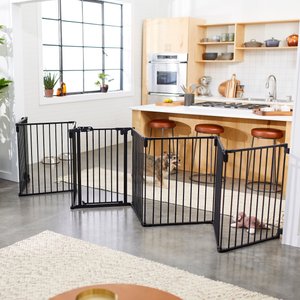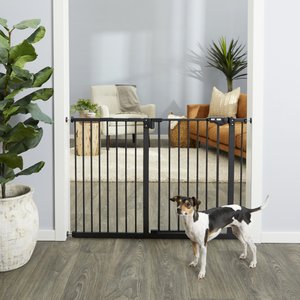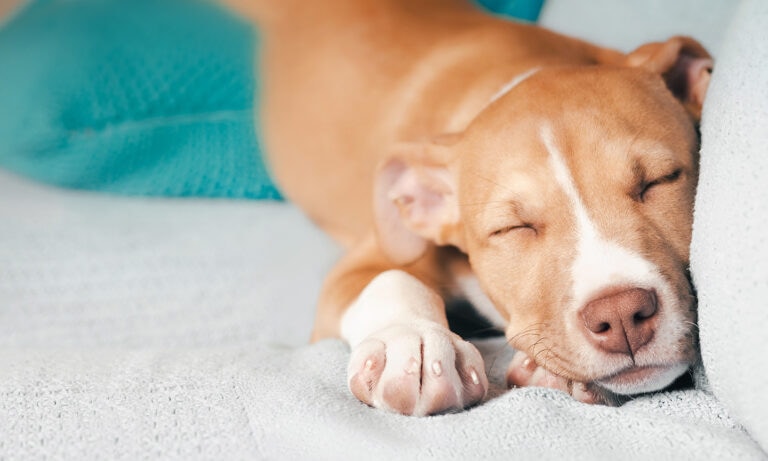In This Guide:
At What Age Can Puppies Use Stairs?
The ideal age for puppies to start using stairs is 12–16 weeks of age.
You might have noticed young puppies aren't exactly coordinated or nimble before they reach this point. This is partly due to their inexperience with the world and things like gravity, but also because their joint strength isn’t very good yet, notes professional dog trainer Erin Askeland, CPDT-KA, CBCC-KA, Camp Bow Wow’s animal health and behavior expert based in Atlanta.
Puppies’ inherent incoordination causes them to be a little more on the clumsy side, which isn’t ideal when climbing stairs.
Another issue they may have before reaching this age is their size. As cute as they are, this petite puppy package makes using the stairs nearly impossible. Think about the scale of a single stair in comparison to their body, then imagine having to make that climb yourself. Whew!
While 12–16 weeks is a good benchmark, Askeland says there’s some nuance here.
“When puppies can use the stairs is dependent on the size and health of the puppy, as some dogs this age are still not big enough to safely navigate the stairs, or if a puppy has a medical condition that may be impacted by stair use,” she says.
When in doubt, ask your veterinarian for advice.
Are Stairs Bad for Puppies?
It’s a bit of a stretch to say that stairs are bad for puppies. However, it’s important to make sure they’re only using stairs when it’s age-appropriate, and only after they’ve been carefully taught how to properly navigate them. To prevent spills and slips, it’s also vital to install safety mechanisms that make the stairs easier for them to use.“Pets using stairs is generally safe with proper supervision, but safety protocols like ensuring non-slip surfaces; avoiding speedy ups and downs on the stairs; and considering those living in the house and how to navigate safely together are imperative,” says Askeland.
Are Stairs Bad for Puppies’ Hips?
Again, stairs aren’t necessarily bad for puppies, but Askeland says excessive use can potentially impact their developing hips and joints.To keep their bodies in shape, practice moderation, safety, and supervision when teaching your dog to use stairs. You may also want to limit their access to stairs when you’re not around by puppy-proofing all staircases in your home.
How to Puppy Proof Stairs
Puppy proofing stairs keeps your floof out of harm’s way until they’ve graduated from puppyhood and can navigate stairs with ease. Follow this excellent advice from Bradley Phifer, CBCC-KA, CPDT-KSA, CCPDT, executive director and owner of Bradley Phifer Dog Training in Indianapolis:- Close doors. Blocking access to stairs by closing a door may be your easiest way to keep them away from staircases until they’re old enough to use them.
- Install stair gates. “Use pet gates to block off access to stairs when your puppy is not supervised,” Phifer says. “This will prevent them from accidentally tumbling down or climbing up without your knowledge.” Place one at either the top or bottom of the stairs, depending on what part of the house you want them to stay in.
- Utilize non-slip surfaces. If your stairs have slippery surfaces, consider adding carpet runners or non-slip treads like these ones from Bungalow Flooring to provide better traction for your puppy, Phifer says.
- Block off open risers. Don’t overlook your sweet doggy’s curiosity, nor their ability to sneak into tiny spaces. “If your stairs have open risers, consider adding a barrier or covering them to prevent your puppy from slipping through or getting stuck,” Phifer says. If your balusters are spaced widely, block them off as well.
- Remove hazards. Keep your stairs free of objects that can cause your puppy to slip or trip. This includes shoes, toys or items you set at the base of the stairs to take up with you later.
- Ensure good lighting. Though most pups have pretty good eyesight, good lighting will help cut down on trips and falls when your puppy is using the stairs.
How To Teach Your Puppy To Take the Stairs
Unless you plan to use a pet gate for years, it’s important to ensure your pup knows how to safely use any stairs in your home.
Phifer says it’s important to gradually introduce your puppy to the stairs so they become familiar with them.
You’ll also want to curb poor usage (like zooming up and down) to help keep them safe.
1 Start Small
You wouldn’t climb Mount Everest in a day, and your pup probably isn’t keen on taking the whole staircase on their first go.
Start small by letting them practice their moves on one or two steps. Place your puppy on the bottom step (or the second from the bottom), then sit at the bottom of the stairs with a yummy treat to help lure them down.
To practice going up, place a treat on the second or third step and allow them to make their way up. Give them mighty praise for their accomplishment!
You can reverse these steps to teach them to go back down the stairs, too.
2 Add More Steps
Once your pup has the hang of a couple steps, add a few more to the mix.
Repeat the same process as above, only this time with two to three more steps. Keep adding steps until they’re able to take the whole staircase.
This process takes a different amount of time for each dog. Some may get the hang of it in a day or two, while others require weeks of practice.
Askeland notes that smaller dog breeds tend to need more time learning how to use the stairs compared to larger breeds. Remain patient!
3 Teach Cues
Teaching dog training cues such as “go ahead” and “wait” provide dog parents with more control over how and when their dogs use the stairs, Askeland says.
“It can be helpful for busy households or for when you don’t want your dog to run up or down the stairs with you,” she says.
4Curb Unsafe Stair Usage
While your dog may be cautious in those early days of learning how to use the stairs, they may become a little too comfortable with them over time.
Zooming up and down the stairs isn’t ideal for their little bodies and can put them at risk of slipping and falling.
If you see your pup zooming up the stairs, curb this behavior. You may need to use a pet gate to block their access while they’re unsupervised.
Are Stairs Bad for Adult Dogs?
Stairs aren’t inherently bad for dogs, but it’s important to be mindful of your pup’s abilities.
“Adult dogs may need to avoid stairs if they have mobility issues, joint problems, or other health conditions—like recovering from surgery—that make stair use challenging or painful,” Askeland says.
This may be more of an issue in older dogs who generally struggle navigating things around them that were once easy, particularly if they have hip dysplasia; arthritis and stiffness; or muscle atrophy.
Generally speaking, make sure you’re curbing unsafe usage, such as zooming up and down stairs, in both puppies and adult dogs.
Should Some Dog Breeds Not Climb Stairs?
There are certain dog breeds that don’t do well on stairs. These include pups with long backs and short legs, such as Dachshunds, Corgis, and Basset Hounds, who are more at risk for back injuries.Small dogs, like Chihuahuas and toy Poodles, may struggle on steps simply because their bodies and legs are so tiny. You’ll also want to more closely monitor certain large dog breeds prone to hip dysplasia and other joint issues, such as German Shepherds, Labrador Retrievers, Golden Retrievers, and Great Danes.
Best Staircase Gates for Dogs
A staircase or pet gate is one of the best ways to keep your puppy off the stairs until they’re ready to learn this skill.
You may also want to use a gate to prevent dogs from accessing the stairs while you’re away from home or they’re otherwise not supervised.
FAQs About Puppies on Stairs
Q:
Do puppies know not to go down stairs?
A:Puppies are naturally curious and don’t instinctively understand that going up and down stairs isn’t always safe.
That said, “Stairs can be intimidating obstacles for puppies, and they may approach them with caution or curiosity depending on their individual temperament,” Phifer says.
Q:
Should I teach my dog how to use the stairs?
A:Yes. Whether you’re working with a puppy or a mature dog, it’s important for dog parents to provide proper training to help their pet navigate stairs safely.
“This training usually involves teaching the puppy to go up and down stairs gradually, a few steps at a time,” Phifer says, “using positive reinforcement, patience, and encouragement.”
Q:
What should I do if my dog is afraid of the stairs?
A:Never force or trap a dog on stairs, as this can result in panic, added fear, and a potential injury.
If your pup is afraid of stairs and it’s not because of a physical ailment, you can encourage them gently with treats and praise.
Askeland also suggests using a ramp or starting with smaller steps to build their confidence.
Once they’re old enough, teaching your dog to use the stairs from a young age can help them become more comfortable with this odd obstacle in your home. Remain patient as they learn and understand that this process can take time.
Simple cues, such as “stay,” “wait,” and “go ahead,” learned as part of their basic obedience training, can provide more control over their stair usage and keep your pup safe.
Expert input provided by Erin Askeland, CPDT-KA, CBCC-KA, Camp Bow Wow’s animal health and behavior expert located in Atlanta; and Bradley Phifer, CBCC-KA, CPDT-KSA, CCPDT, executive director and owner of Bradley Phifer Dog Training in Indianapolis.
This content was medically reviewed by a veterinarian.
Keep Your Pup Safe
Share:














